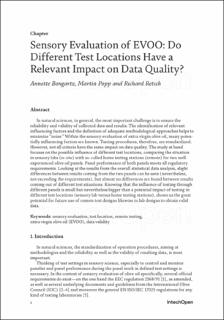Please use this identifier to cite or link to this item:
https://doi.org/10.21256/zhaw-25088| Publication type: | Book part |
| Type of review: | Peer review (publication) |
| Title: | Sensory evaluation of EVOO : do different test locations have a relevant impact on data quality? |
| Authors: | Bongartz, Annette Popp, Martin Retsch, Richard |
| et. al: | No |
| DOI: | 10.5772/intechopen.102702 10.21256/zhaw-25088 |
| Published in: | Olive Cultivation |
| Editors of the parent work: | Yonar, Taner |
| Issue Date: | 2022 |
| Publisher / Ed. Institution: | IntechOpen |
| Publisher / Ed. Institution: | London |
| Language: | English |
| Subjects: | Sensory evaluation; Test location; Remote testing; Extra virgin olive oil (EVOO); Data validity |
| Subject (DDC): | 664: Food technology |
| Abstract: | In natural sciences, in general, the most important challenge is to ensure the reliability and validity of collected data and results. The identification of relevant influencing factors and the definition of adequate methodological approaches helps to minimize “noise.” Within the sensory evaluation of extra virgin olive oil, many potentially influencing factors are known. Tasting procedures, therefore, are standardized. However, not all criteria have the same impact on data quality. The study at hand focuses on the possible influence of different test locations, comparing the situation in sensory labs (in situ) with so-called home testing stations (remote) for two wellexperienced olive oil panels. Panel performance of both panels meets all regulatory requirements. Looking at the results from the overall statistical data analysis, slight differences between results coming from the two panels can be seen (nevertheless, not exceeding the requirements), but almost no differences are found between results coming out of different test situations. Knowing that the influence of testing through different panels is small but nevertheless bigger than a potential impact of testing in different test locations (sensory lab versus home testing stations), shows us the great potential for future use of remote test designs likewise to lab designs to obtain valid data. |
| URI: | https://digitalcollection.zhaw.ch/handle/11475/25088 |
| Fulltext version: | Published version |
| License (according to publishing contract): | CC BY 3.0: Attribution 3.0 Unported |
| Departement: | Life Sciences and Facility Management |
| Organisational Unit: | Institute of Food and Beverage Innovation (ILGI) |
| Appears in collections: | Publikationen Life Sciences und Facility Management |
Files in This Item:
| File | Description | Size | Format | |
|---|---|---|---|---|
| 2022_Bongartz-etal_Sensory-evaluation-of-EVOO-different-test-locations.pdf | 2.61 MB | Adobe PDF |  View/Open |
Show full item record
Bongartz, A., Popp, M., & Retsch, R. (2022). Sensory evaluation of EVOO : do different test locations have a relevant impact on data quality? In T. Yonar (Ed.), Olive Cultivation. IntechOpen. https://doi.org/10.5772/intechopen.102702
Bongartz, A., Popp, M. and Retsch, R. (2022) ‘Sensory evaluation of EVOO : do different test locations have a relevant impact on data quality?’, in T. Yonar (ed.) Olive Cultivation. London: IntechOpen. Available at: https://doi.org/10.5772/intechopen.102702.
A. Bongartz, M. Popp, and R. Retsch, “Sensory evaluation of EVOO : do different test locations have a relevant impact on data quality?,” in Olive Cultivation, T. Yonar, Ed. London: IntechOpen, 2022. doi: 10.5772/intechopen.102702.
BONGARTZ, Annette, Martin POPP und Richard RETSCH, 2022. Sensory evaluation of EVOO : do different test locations have a relevant impact on data quality? In: Taner YONAR (Hrsg.), Olive Cultivation. London: IntechOpen
Bongartz, Annette, Martin Popp, and Richard Retsch. 2022. “Sensory Evaluation of EVOO : Do Different Test Locations Have a Relevant Impact on Data Quality?” In Olive Cultivation, edited by Taner Yonar. London: IntechOpen. https://doi.org/10.5772/intechopen.102702.
Bongartz, Annette, et al. “Sensory Evaluation of EVOO : Do Different Test Locations Have a Relevant Impact on Data Quality?” Olive Cultivation, edited by Taner Yonar, IntechOpen, 2022, https://doi.org/10.5772/intechopen.102702.
Items in DSpace are protected by copyright, with all rights reserved, unless otherwise indicated.